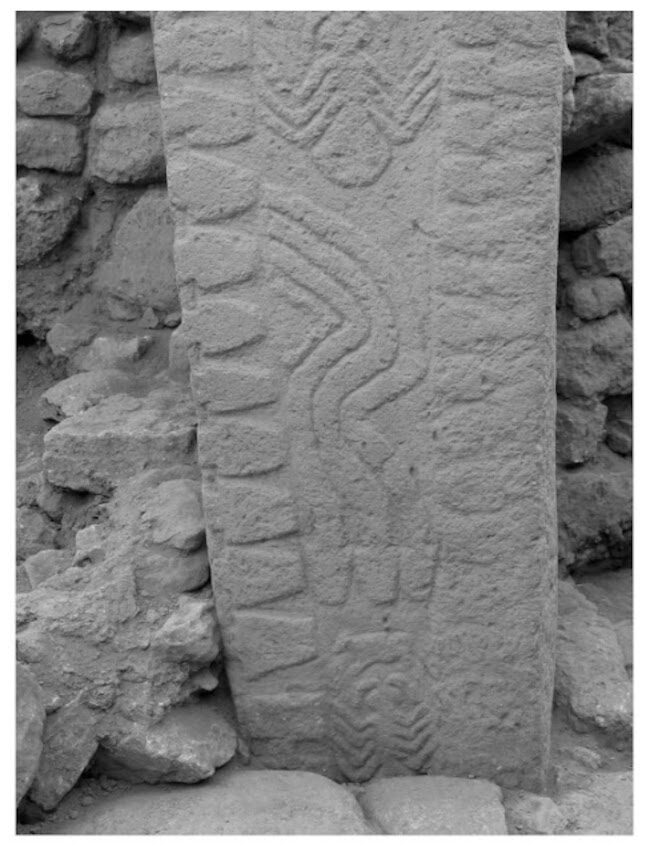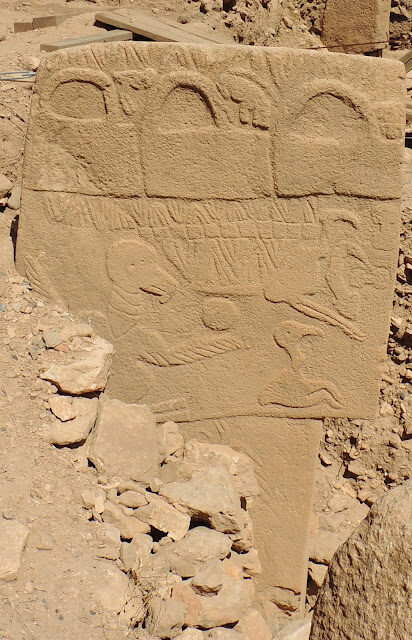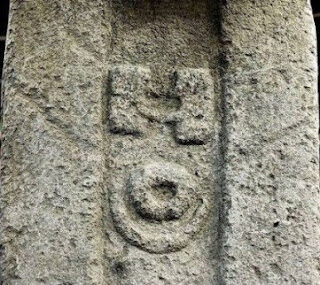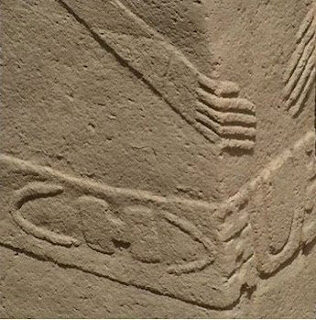The H and I-symbols at Gobekli Tepe are some of the hardest to decipher, and their precise meaning remains obscure.
But there are some good clues, which allow a preliminary interpretation.Let's have a look at all the instances where H and I-symbols occur.
Pillar 33: I-symbols can just be seen at the bottom of the inner face, next to the lower spider. There is also a faint one higher up above the top spider.

© PreHistory Decoded
Also, there are more I-symbols on the side with the tall bending birds.

© PreHistory Decoded
Of course, Pillar 43 has H and I-symbols near the bird with fish/snake.

© PreHistory Decoded
But Pillar 18 has the most H and I-symbols. First, at the top, forming a kind of necklace, together with likely sun and moon symbols.

© PrehHistory Decoded
Then on the belt of Pillar 18 surrounded by loops...

© PrehHistory Decoded
And then also on the belt buckle surrounding what might be the head of a comet.

© PrehHistory Decoded
Pillar 30 has a single H-symbol,

© PreHistory Decoded
... while Pillar 28 has an H-symbol on top of another loop, with an I-symbol at the bottom. The loop behind the H-symbol here looks to be similar to the loops and H-symbols on the belt of Pillar 18.

© PreHistory Decoded
So how can we make sense of all these H and I-symbols?
Starting with Pillar 43, the H and I-symbols seem to be interchangeable. Probably they have a very similar meaning. Given also we have decoded a sky-scene and a calendar on Pillar 43, their meaning is clearly astronomically-related, and might indicate either an object in the sky or a unit of time, or something related to these concepts, like the milky way or a pole star.
Now, looking at Pillar 18, we see H and I-symbols surrounding what
might be the nucleus of a comet. So it seems they might represent the stars, or the night-sky itself? At the top of Pillar 18 we have what is presumably the sun and moon next to an H-symbol. Again, this suggests an object in the sky or a unit of time. But considering the sun and H-symbol (and probably the moon too) are each obscured by a dimple, it now seems clear they represent an object in the sky, rather than a unit of time or a notational device, that can be obscured like the sun can be. Given these symbols appear in a wide range of contexts, probably they represent the sky itself, or the stars, or specific stars in the sky, or the milky way.
Probably, then, I expect the H and I-symbols represent the sky itself, especially the night-sky, which can also be used to indicate a scene in the sky; a kind of notation which says, for example 'this is a scene in the sky, and not an actual animal'.
But why are there both H and I-symbols? Possibly, this is because these shapes tesselate. I suspect, therefore, that they represent the dome of the sky itself, especially the night-sky, rather like the Ancient Greek notion of the celestial sphere, or a celestial dome.
So what do the dimples on Pillar 18 mean? As already mentioned, the dimples seem to obscure the sun, moon and sky. And symbols at the neck in general seem to imply control; the being sporting a symbol at the neck has control over that object or phenomenon.
In the context of the Younger Dryas impact event, which seems to unite the symbolism at Gobekli Tepe, these dimples might, therefore, represent the obscuring ash and soot cloud of the impact. This impact cloud is thought to have obscured the sky, to complete darkness, for a matter of weeks right after the impact event. This would definitely have been an effect worth noting and remembering. So Pillar 18, therefore, probably represents a being, that has control, not over the sun, moon and sky, but over the ability to obscure them, represented by the dimples. Considering that Pillar 18 is wearing a belt buckle and fox-pelt loincloth, it seems that it represents the impacting comet itself, which came from the direction of fox constellation (thought to be Aquarius, the central radiant point of the Taurid meteor stream), with the ability to obscure the sun, moon and stars.
So, what of the loops surrounding the H-symbols on Pillar 28 and the belt of Pillar 18? They are puzzling. But perhaps, after the impact, a ring of debris became visible in the sky - perhaps Earth had a ring! Or perhaps they represent the path of the planets along the ecliptic (not that they would necessarily have known these paths were circular!), or perhaps the milky way, or the zodiacal dust cloud. The zodiacal dust cloud would have been more noticeable back then than it is now, due to the presence of a giant decaying comet in the inner solar system. On the other hand, considering the H-symbols seem to represent the night's-sky, perhaps the ring represents the motion of the sky which completes an entire revolution every day? Whatever, these rings are perhaps the most puzzling symbols yet seen.
Perhaps they represent a more abstract idea we can only guess at until further evidence is uncovered.
Anyone reading this would think he knew what he were on about " Prehistory Decoded " , I doubt he could read the small print on a packet of crisps.
I have libraries of evidence of such symbols being used GLOBALLY. How could that be so?
" Perhaps they represent a more abstract idea we can only guess at until further evidence is uncovered " , what a cop out, shows he knows bugger all about this subject.